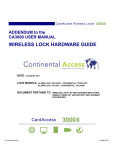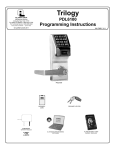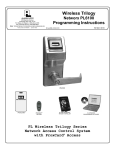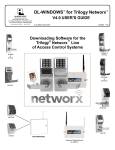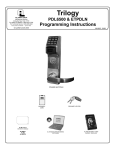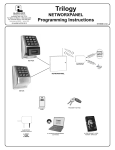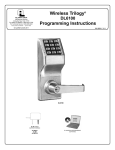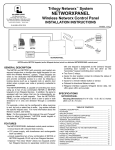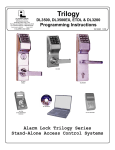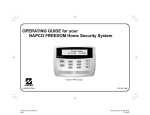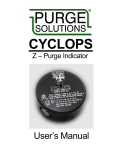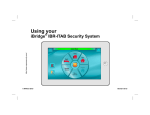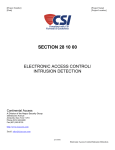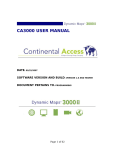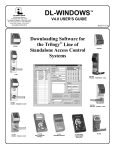Download - Napco Security Technologies
Transcript
CardAccess Wireless Locks
ADDENDUM to the
CA3000 USER MANUAL
WIRELESS LOCK INTEGRATION GUIDE
DATE :
2 AUGUST 2011
SOFTWARE VERSION AND BUILD :
DOCUMENT PERTAINS TO :
VE RSI ON 2.8.2.229 AND HIG HE R
I N STAL L ATI O N AN D P RO GR AM M I N G
AL ARM L OCK W IRELE SS LOCKS INTO THE
CONTINENTAL ACCESS CA3000 CONTROL
SYS TE M
CardAccess
© Continental 2011
Wireless Lock Integration Guide
WI1949 8/11
1
FCC WARNING
Changes or modifications to this unit not expressly approved by the party responsible for compliance could void the
user’s authority to operate the equipment.
NOTE
This equipment has been tested and found to comply with the limits for a Class A digital device, pursuant to Part 15 of
the FCC Rules. These limits are designed to provide reasonable protection against harmful interference when the
equipment is operated in a commercial environment. This equipment generates, uses, and can radiate radio frequency
energy and, if not installed and used in accordance with the instruction manual, may cause harmful interference to radio communications. Operation of this equipment in a residential area is likely to cause harmful interference in which
the user will be required to correct the interference at his own expense.
Shielded cables must be used with this unit to ensure compliance with the Class A FCC limits.
"This digital apparatus does not exceed the Class A limits for radio noise emissions from digital apparatus set out in the
Radio Interference Regulations of the Canadian Department of Communications.”
Le present appareil numerique n’ émet pas de bruits radioélectriques dépassant les limites applicables aux appareils
numeriques de la class A prescrites dans le Réglement sur le brouillage radioélectriques edicté par le ministere des
Communications du Canada.
DISCLAIMER
Continental Instruments LLC makes no representations or warranties with respect to the contents hereof and specifically disclaims any implied warranties of merchantability or fitness for any particular purpose. Further, Continental Instruments LLC reserves the right to revise this publication and to make changes from time to time in the content hereof
without obligation of Continental Instruments LLC to notify any person of such revision or changes. If possible, always
refer to the Continental Access website (www.cicaccess.com; click Support) for the latest documentation, as the released CD may not contain the latest documentation.
Copyright © 2011 by Continental Instruments LLC. All rights reserved. No part of this publication may be reproduced, transmitted, transcribed, or stored in a retrieval system, without the prior written permission of Continental Instruments LLC, 355 Bayview Avenue, Amityville, NY 11701. Telephone: 631-842-9400 • FAX: 631-842-9135 • GSA#
GS-07F-0039H.
ProxCard® and ProxKey® are trademarks of the HID© Corporation. Microsoft® and Windows® are trademarks of their
the Microsoft Corporation. Trilogy® is a registered trademark of Alarm Lock. All other trademarks, service marks, and
product or service names described in this manual are for identification purposes only and may be trademarks or registered trademarks of their respective owners.
The absence of a name or logo in this document does not constitute a waiver of any and all intellectual property rights
that NAPCO Security Technologies, Inc. or Continental Instruments LLC has established in any of its product, feature,
or service names or logos.
This document contains proprietary information of NAPCO Security Technologies. Unauthorized reproduction of any
portion of this manual without the written authorization of NAPCO Security Technologies is prohibited. The information
in this manual is for informational purposes only. It is subject to change without notice. Companies, names and data
used in examples herein are fictitious unless otherwise noted. NAPCO Security Technologies assumes no responsibility for incorrect information this manual may contain.
A NAPCO SECURITY TECHNOLOGIES COMPANY
Publicly traded on NASDAQ
Symbol: NSSC
Visit our websites at
http://www.cicaccess.com/
http://www.napcosecurity.com/
http://www.alarmlock.com/
2
Wireless Lock Integration Guide
Table of Contents
Overview ..........................................................................................................................................4
Capacity ...........................................................................................................................................4
Network Security .............................................................................................................................4
How to Use This Manual .................................................................................................................4
Ordering Information .......................................................................................................................5
CA3000 System Requirements .......................................................................................................5
Gateway Specifications...................................................................................................................6
Network Considerations .................................................................................................................7
Terminology .....................................................................................................................................9
Gateway Hardware Installation .....................................................................................................10
Resetting the Gateway ..................................................................................................................12
Quick Start: Add Gateways and Locks ......................................................................................13
Gateways > Discover Gateways ...................................................................................................19
Gateways > Update Gateway Status ............................................................................................20
Gateways > Send Firmware to Gateway ......................................................................................21
Gateways > Send Config Table to Gateway.................................................................................22
Gateways > Replace Gateway ......................................................................................................23
Gateways > Remove Gateway ......................................................................................................24
Gateways > Configure Network Settings .....................................................................................25
Locks > Discover Locks ................................................................................................................27
Locks > Locate All Locks ..............................................................................................................28
Locks > Display Configured Locks ..............................................................................................29
Locks > Set Clock on All Locks ....................................................................................................31
Troubleshooting ............................................................................................................................32
Radio and Television Interference Statement .............................................................................35
Alarm Lock Limited Warranty .......................................................................................................36
Wireless Lock Integration Guide
3
Overview
Lock
#1...
Up to 63 locks for each
Gateway...
io
Rad
W
W ire
d (R
J-45
)
or W
irele
ss
PC Running
CA3000 Software
CA3000 software is installed on a computer that is connected to a network (either a small Ethernet network or
large corporate LAN). Connected to this network is an
intermediate device called a Gateway that communicates
via a private wireless signal to a radio located inside
each door lock. In this way, the software allows full programming and control of each lock in the system. Note:
In this manual, the word "lock" refers to all Networx™ series door locks.
To ensure each physical lock is identified correctly by the
CA3000 software, the factory assigns each lock a unique
Serial Number; after locks are installed on the doors and
the Gateways are mounted, the Gateways search for
new locks, allowing them to be enrolled into the system.
Note: Although you can set up the wireless network first
and add locks to the doors later, for the sake of convenience it is recommended that you have at least one Networx™ lock installed on a door before setting up your
wireless system. Note that stand-alone individual lock
programming at the lock keypad is not supported; in
other words, the door lock may only be placed into operation by the use of the CA3000 software. For more information, see the Wireless Lock Hardware Guide
(WI1969).
J
(R
-4
les
ire
Existing
Corporate
Ethernet
Network
Rad
io )
5)
.11
02
s8
)))
)
Lock
#63
E X P A N D A B L E
...Up to 255 Gateways in each
system
Wi
red
Control Panel
Used with the Trilogy Networx™ series locks and keypads, the CardAccess CA3000 software allows you to
upload and download programming features wirelessly
using a computer network. Use your computer to retrieve events, download badge / time schedules / badge
formats and program features into each wireless lock in
the system.
d
ire
W
or
or
W
OVERVIEW
4
))
GATEWAY
#1
Polling Cable
Reader
)))
(
RJ
-45
ire
les
)
s8
02
.11
GATEWAY
#255
Rad
io
)))
)
Lock
#16,065
CAPACITY
In addition, each installed system can contain 255 Gateways--and each Gateway can control up to 63 locks--for
a maximum of 16,065 locks allowed. Furthermore, each
Continental Networx lock can contain 3000-4000 badges
(depending on configuration).
NETWORK SECURITY
The system uses AES (Advanced Encryption Standard)
to protect the integrity of the data flow between the wireless router/network and the Gateways.
HOW TO USE THIS MANUAL
CA3000 software is the basis for wireless lock programming. For those unfamiliar with using CA3000 software, stop here and review the CA3000 User Manual. It
may be helpful to create a "test Account" in CA3000
while walking through the examples presented in this
User Guide.
If you are already familiar with CA3000, the transition to
working with wireless locks will be straightforward with
slight additions in terminology. This manual can be read
from beginning to end, or can be used with the table of
contents as a reference manual.
●
To install locks on the doors first, use the Installation Instructions for the lock model you wish to install,
then use the Wireless Lock Hardware Guide
(WI1969) to put the locks into use.
●
To set up the wireless Networx system and connect the network to CA3000, go to the "Network
Considerations" section on page 7.
Wireless Lock Integration Guide
Overview (cont'd)
ORDERING INFORMATION
Several Gateway device models are available; all have
the two antennas used to transmit to the locks via an
Alarm Lock proprietary radio connection.
● Gateway "Wireless/Wired" AL-IM80211 - Hardwired/
Wireless Gateway Interface Module. Supplied with its
own Class 2 transformer to supply power; connection to
a network is supported via either a wired connection
(using a standard RJ-45 Ethernet cable) or a wireless
connection (using a third antenna for 802.11 transmissions). Ensure adequate 802.11 coverage in the area
where the "Wireless/Wired" Gateway is mounted. Supports up to 63 Networx Locks. Ceiling- or wallmountable.
● Gateway "Wired" AL-IME - Hardwired Gateway Interface Module, supports up to 63 Networx Locks, connects directly to a network using a standard RJ-45
Ethernet cable. Ceiling- or wall-mountable; powered
with Class 2, 6VAC transformer (supplied).
● Gateway "Power over Ethernet" AL-IMEPOE - Hardwired Gateway Interface Module + POE (Power Over
Ethernet), supports up to 63 Networx Locks, connects
directly to a network using a standard RJ-45 Ethernet
cable and POE. Ceiling- or wall-mountable.
● Gateway "Plenum Rated POE" AL-IMEPOEP - Same
as above "AL-IMEPOE", with added enclosure protections and installation hardware for mounting above
"drop-ceiling" tiles or other locations subject to air pressure changes (HVAC air-filled spaces, etc.).
Note: Alarm Lock door lock models not yet converted to
the CA3000 system begin with "DL", "PL" or "PDL" (for example "PDL6100". Locks converted to the CA3000 system
have the letter "C" added before the "DL", "PL" or "PDL"
letters (for example, an Alarm Lock model "PDL6100" becomes a "CPDL6100" when converted for use with
CA3000.
● CPDL6100/26D - Cylindrical Trilogy® Networx™ Wireless Access Control Lock with built in HID Proximity ID
Card Reader, full-metal digital keypad, integral bidirectional radio, 4 C-cell battery-operated (batteries
supplied), serial number ID card, standard format SCI
keyway for manual key override, 4⅞" ASA Strike
(included).
● CPL6100 - Cylindrical Trilogy® Networx™ Wireless Access Control Lock with built in HID Proximity ID Card
Reader (keypad removed for added security), integral
bi-directional radio, 4 C-cell battery-operated (batteries
supplied), serial number ID card, standard format SCI
keyway for manual key override, 4⅞" ASA Strike
(included).
ings, Trilogy Exit Trims allow audit trail, multi-users and
auto lock/unlock capabilities. For the highest security
measures, the CETPDLN is outfitted with both PIN and
HID Prox technology. Both CETDLN and CETPDLN
locks come with a rugged, 12-button metal keypad and
a non-handed fully field reversible clutch mechanism to
insure long life and durability. Add, delete, change users at the keypad or use CA3000 software to manage
your system at the PC with ease. Our Trilogy Exit Trims
grant access for up to 2000 users, provide 40,000 event
audit trail and 500 lock/unlock scheduled events with
time zone support. Also available for purchase is our
proximity-only Exit Trim model (ETPLN).
● WI1674 - CPDL6100 Installation Instructions.
● WI1676 - CPDL6100 Door Installation Template.
See www.cicaccess.com for a complete list of all available standard Trilogy and Networx™ series devices and
manuals (downloadable in PDF format).
CA3000 SYSTEM REQUIREMENTS
Minimum Server (1-4 Workstations) Software and Hardware
Requirements:
Processor - Pentium Dual Core, 2.6GHz (min)
Ram - 2.0 GB Min/ 3GB+ for Win 7 and Win Server 2008
Hard Drive - 300 GB
USB Ports - 4 Min
Serial Ports - Optional - 1 expandable to 64
Parallel Ports - Optional - 1
Mouse - PS2 or USB
Monitor - 17" SVGA (1024x768)
CD/DVD ROM - 48x/16x
CDRW/DVDR - 24x/8x
Sound - Optional but Stand-Alone recommended
Network Card - 100/1000 Mb NIC Ethernet
Operating System - Win XP Pro w/SP3, Win 7 Pro 32/64
bit, Win 2003 Server 32/64 bit, or Win 2008 Server
32/64 bit.
Database - MS SQL 2005/2008 Express or MS SQL
Server 2005/2008 for higher performance
Backup - Tape / CD / DVD / Network
System Size - This is the recommended PC server specification for a system with up to four workstations. It can
be used for a stand-alone system, a workstation or a
CA3000 Server. For high transaction environments
some specifications may change.
Notes: - (1) If using SQL Express, the database size
should not exceed 4GB. (2) Disk drive usage is dependent on the number of transactions kept in backup.
(3) Additional RAM will improve performance (4) It is
best to perform badge and other integration functions
on a workstation, not the server.
● CETPDLN, CETDLN & CETPLN - Networx™ Wireless
standalone access control exit trims for most major
manufacturers of exit devices. Ideal for securing exterior doors in schools, hospitals and commercial buildWireless Lock Integration Guide
5
Overview (cont'd)
GATEWAY SPECIFICATIONS
Note: For all Gateway modules, network activity or
bandwidth usage does NOT occur until the user operates
the CA3000 software to send programming to (or receive
log data from) locks.
Model AL-IM80211
AL Radio Link
900MHz GFSK
50 Channels
10mW power output
Input Power
Voltage: 5 - 6 volts AC/DC
Environmental
Operating Temp: -20° to 60°C (-4° to 140°F)
Storage: -40° to 85°C (-40° to 185°F)
("Wireless/Wired" Gateway)
Wireless Specifications
Wireless Standards: IEEE 802.11b; 802.11g
Frequency Range: 2.412 – 2.484 GHz
Output Power: 14dBm +1.5 dBm/-1.0 dBm
Maximum Receive Level: -10dBm (with PER < 8%)
Data Rates with Automatic Fallback: 54Mbps –
1Mbps
Range: Up to 328 feet indoors
Modulation Techniques: OFDM, DSSS, CCK,
DQPSK, DBPSK, 64 QAM, 16 QAM
Network Interface
Interface: Wireless 802.11b, 802.11g and 10/100
Ethernet
Protocols: TCP/IP, UDP/IP, DHCP
Security
IEEE 802.11 - PSK with AES Encryption 128-bit
Power Consumption
Average Power Consumption:
● 1300mW (WLAN mode; maximum data rate)
● 300mW (WLAN mode; idle)
● 750mW (Ethernet mode)
Peak Supply Current: 650mA
Input voltage: 5 - 6 volts AC/DC
Environmental
Operating Temp: -20° to 60°C (-4° to 140°F)
Storage range: -40° to 85°C (-40° to 185°F)
Model AL-IMEPOE
("Power Over Ethernet" Gateway)
Model AL-IMEPOEP
("Plenum Rated POE" Gateway)
Network Interface
Interface: Ethernet 10Base-T or 100Base-TX (using
RJ-45 jack)
Protocols: TCP/IP, UDP/IP, DHCP
Encryption
128-bit AES Rijndael encryption
AL Radio Link
900MHz GFSK
50 Channels
10mW power output
Input Power
POE Voltage: 48 volts DC nominal
Class 2
Environmental
Operating Temp: -20° to 60°C (-4° to 140°F)
Storage: -40° to 85°C (-40° to 185°F)
Compliance
802.3af POE Standard (AL-IMEPOEP only)
UL 2043: UL Standard for Safety Fire Test for Heat
and Visible Smoke Release for Discrete Products
and Their Accessories Installed in Air-Handling
Spaces
Model AL-IME
("Wired" Gateway)
Network Interface
Interface: Ethernet 10Base-T or 100Base-TX (using
RJ-45 jack)
Protocols: TCP/IP, UDP/IP, DHCP
Encryption
128-bit AES Rijndael encryption
6
Wireless Lock Integration Guide
Netw ork Considerations
This section will help you define the steps required to suit the
specific needs of your installation. Note: Refer to the Terminology section on page 9.
SUBNETS
Use the following information when installing multiple wireless
Networx Gateways within a corporate Intranet that contains
multiple "subnets".
To improve security and processing performance, corporate
Intranets are often divided into interconnected but separate
segments called "subnets". The IP (Internet Protocol) address is a unique address of a device (such as a computer or
a Gateway) connected to a TCP/IP corporate Intranet.
CA3000 can only Discover Gateways when the Gateways
are connected to the same subnet to which CA3000 is also
connected.
IP addresses are written as four groups of numbers separated by periods; these groups are called "octets". IP addresses can be permanent ("static") or dynamically assigned
(by DHCP) when a device, such as a Gateway, is powered.
Class B Subnets
Some corporate Intranets contain multiple "Class B" subnets;
the "Class B" refers to the octet that does not change, if naming each octet from left to right. An example of two "Class B"
subnets where the first two octets of each network IP address
remain the same are:
A
B
C
D
● Subnet 173.16.100.xxx
● Subnet 173.16.200.xxx
In this example, the "A" and "B" octets "173" and "16" are the
same within the network. (Note: The "xxx" is a way of showing a variable number).
Subnet
173.16.100.xxx
Subnet
173.16.200.xxx
ROUTER or
SWITCH or SERVER
GATEWAY
GATEWAY
Why we recommend using static IP addresses
We recommend using static IP addresses for each Gateway
you install because they have the following advantages:
● CA3000 software performs more smoothly because the
software does not have to waste time re-locating Gateways that have had their IP addresses changed by
DHCP;
● Static IP addresses allow operation across subnets in
large corporate networks (such as those that exist between buildings);
Contact the Network Administrator
If you know that you will install your wireless Networx system within a large corporate network that includes multiple
subnets, we recommend you start by contacting the corporate network administrator and request the following:
●
IP Address - An address for each Gateway device
___________________________________________
●
Subnet Mask - Filtering data (mask bits) as required by
the aforementioned IP Address
___________________________________________
●
Default Gateway - The address of the physical device,
such as a router, for the current subnet to which CA3000
will be connected
___________________________________________
GATEWAY
GATEWAY
GATEWAY
GATEWAY
GATEWAY
GATEWAY
GATEWAYS ON DIFFERENT SUBNETS WITHIN A NETWORK
As shown in the image above, if the computer running
CA3000 is connected to the first subnet (173.16.100.xxx),
and several Gateways are connected to the second subnet
(173.16.200.xxx), CA3000 will ONLY be able to communicate
with the Gateways on the second subnet when:
● ALL Gateways use only static IP addresses, and
Wireless Lock Integration Guide
The network administrator may decide to use routing tables
or may specify blocks of addresses through which the two
subnets can freely communicate in both directions. Regardless of the method selected, your network administrator must
determine the range of network addresses to assign to the
Gateways and to the CA3000 computer. As shown below,
three address fields must be obtained from your network administrator: IP Address, Subnet Mask, and Default Gateway.
In addition, inquire about wireless authentication and encryption, as required.
GATEWAY
PC Running
CA3000
Software
● The network administrator allows for open addressing
between the two subnets in the network
ASSIGNING STATIC IP ADDRESSES
TO GATEWAYS
CA3000 can only Discover Gateways when the Gateways
are connected to the same subnet to which CA3000 is also
connected. To allow CA3000 residing on one subnet to
communicate with Gateways located on a second subnet
(with both subnets located within a single network) a typical
installation strategy is:
1. Estimate the number of Gateways needed in the installation.
2. Install CA3000 on a PC connected to the first subnet (for
example, plug the PC into a wall network outlet the network administrator confirms is wired to the first subnet).
3. Open CA3000 and create a new (or open an existing)
Account.
7
Network Considerations (cont'd)
4. Power up a Gateway and connect the Gateway to the
same (first) subnet to which CA3000 is connected (in the
example above, "173.16.100.xxx"). This connection to
the first subnet may be through a second network socket
in the wall, or to a router (or switch) connected to the
same network socket in the wall that the CA3000 PC is
also connected.
5. In CA3000, discover and assign the Gateway.
6. In the Gateway Configuration screen, click Tools, Configure Network Settings. In the Network Configuration screen, (shown below) uncheck Use DHCP, and a
warning popup appears:
As shown in the above popup, the Gateway may take
several seconds up apply the new settings. If the Gateway does not respond, click Gateways, Update Gateway Status before proceeding. Click OK to close the
popup.
7. Physically disconnect (unplug) the Gateway from the first
subnet, physically relocate and plug the Gateway into the
second subnet (in the example above, from "173.16.100.
xxx" to "173.16.200.xxx). Install the Gateways in their
final locations.
Click Yes to close the warning popup. In the Network
Configuration screen, type the three addresses obtained from your network administrator into the following
three fields:
●
●
●
IP Address
Subnet Mask
Default Gateway
The remaining tasks are to install your locks on the
doors, and have CA3000 Discover them (as outlined in
the section Quick Start: Add Gateways and Locks):
8. Discover physical locks on the Gateway.
9. Assign (add) discovered locks to the Gateway.
(partial screen image shown)
Click Save Configuration and send to Gateway. The
following popup appears:
8
Wireless Lock Integration Guide
Te r m i n o l o g y
The following words are used throughout this manual to
convey specific concepts and/or actions used in the CA3000
software when adding the Trilogy Networx™ series locks .
Assign - Add to hardware or specify a relationship. Can be
used with badges and locks ("to assign badges to specific locks"), or with hardware identification ("the factory
assigns each lock a unique Serial Number"), or a fixed
wireless communication channel between locks and a
Gateway ("locks assigned to a Gateway").
Communicate - To send or receive a transmission. To
avoid the directionally confusing terms of "download" and
"upload", the word "communicate" is used in this guide.
Configure- To "assign" (add) discovered physical locks to a
Gateway (by sending the "Lock Config Table" to the selected Gateway). Configuring ensures a fixed wireless
communication channel exists between selected physical
locks and a selected Gateway.
The Gateway Configuration screen allows you to select
a Gateway and allow that Gateway to discover physical
locks; these physical locks can then be assigned to that
selected Gateway. When the Use Selected Locks button is clicked (in the "DISCOVERED LOCKS" POPUP),
the Gateway sends "configuration data" to the selected
locks. This "configuration data" contains items (such as
an internal lock designation, a specific radio channel and
security data) that are all embedded in what is called a
"Lock Config Table". This "configuration data" instructs
the physical lock(s) to communicate ONLY with that
Gateway and prevents other Gateways from communicating with the physical lock(s).
In short, the Gateway tries to "configure" the selected
physical locks by assigning the selected physical locks to
the Gateway.
DHCP (Dynamic Host Configuration Protocol) - Software
that automatically assigns IP addresses to devices that
are connected to a network. It eliminates having to
manually assign fixed IP addresses.
Discover - To "discover" Gateways, the system searches
for Gateways not yet assigned to an Account; to
"discover" locks, the selected Gateway searches for
locks not yet assigned to Gateways.
Download - See Communicate.
IP Address - The IP (Internet Protocol) address is a unique
address of a device (such as a computer or a Gateway)
connected to a TCP/IP corporate Intranet. IP addresses
are written as four groups of numbers separated by periods; these groups are called "octets". IP addresses can
be permanent ("static") or dynamically assigned (by
DHCP) when a device, such as a Gateway, is powered.
used with a Gateway, refers to re-discovering a "lost"
Gateway device on the network. Used when an operational Gateway has lost its network connection, and appears listed in red colored text on the Gateway Configuration screen.
Lock Config Table - When a Gateway is "discovered" and
added to an Account, CA3000 sends a Lock Config Table to the Gateway. This Lock Config Table is stored in
the Gateway memory, and may or may not contain assigned physical lock data. The table is a database structure that is designed to hold the physical lock data (serial
numbers, etc) when physical locks are "assigned" to the
Gateway.
Panel - A "panel" has two definitions: (1) A wall-mounted
microcomputer-based unit to which detection devices,
access control and/or alarm system devices are ultimately connected and managed. These devices may
include sirens, door contacts, PIR's, credential readers,
etc. Control panels may also include an integral digital
communicator to allow communication with police, fire or
medical personnel. (2) A wireless Networx series door
lock.
Physical - Same as "Real". Tangible, not virtual. See Virtual.
Real - Same as "Physical". Tangible, not virtual. See Virtual.
Subnet (SUBNETwork) - To improve security and processing performance, network administrators often divide
their corporate Intranets into interconnected but separate
segments called "subnets". Subnets also allow multiple
users to access the Intranet with the same subnet address. A router is typically used to allow network traffic
to pass between subnets.
Subnet Mask - The IP protocol makes use of a Subnet
Mask to more efficiently route packets to their correct
network destinations. When a Gateway receives a data
packet, the Subnet Mask indicates how many bits of the
packet's destination address are to be used for routing
and which bits are to be "masked" (ignored). The Subnet
Mask can be thought of as a "filter" that allows the system to ignore unnecessary information, thus increasing
efficiency. This information must be obtained from your
network administrator.
Upload - See Communicate.
Virtual - Simulated on a computer.
Locate - With physical lock(s), the Locate command
causes the physical lock to "beep" and flash its LED
(helpful when you wish to find the physical lock or confirm the lock's wireless connection is operational). When
Wireless Lock Integration Guide
9
Gateway Hardware Installation
HARDWARE INSTALLATION
For a minimum wireless system, you need:
• A laptop or desktop computer (to run CA3000)
• A wired or wireless home router (to allow connection to a computer network)
• An Alarm Lock Gateway module (the intermediary
device between the network and the locks)
Note: Before proceeding, you should have a working
knowledge of CA3000 software. See the CA3000
User Guide for basic information such as how to install and open CA3000, how to create Accounts, how
to add badges, etc.
1. Install the CA3000 software into your computer as
described in the CA3000 User Guide.
2. Connect your computer to a network
If you have access to a "large network" such as an
existing corporate Ethernet network (such as a LAN),
connecting to a network may be as simple as plugging your computer into an RJ-45 wall jack. In this
case, you may wish to contact the Ethernet network
administrator and inform them as to your plans.
Wired (RJ-45)
or Wireless 802.11
PC Running
CA3000
Software
Existing
Corporate
Ethernet
Network
For the connection between your computer and a
large Ethernet network, most laptops and some
desktop computers contain a wireless network card
(also called a "wireless network interface controller")
to allow for wireless communication between your
computer and a this large network. Contact the network administrator for this kind of wireless connection.
For computers without a wireless network card, connect the "non-wireless" network card in your computer to the network as follows: Connect one end of
the Ethernet cable to the computer network card RJ45 socket (usually located at the back of your computer); connect the other end of the cable to the RJ45 socket at a wall jack or a modem that is part of the
corporate Ethernet network / LAN. Note that wall
jack or modem access points usually need to be configured first by the network administrator before the
network will allow a connection.
3. The Network Connection to the Gateway
The connection between the network (the router or
the existing corporate Ethernet network) and the
Gateway device may be either directly wired using
an Ethernet cable --or--wirelessly via 802.11x transmissions, as shown in the illustrations below:
10
Existing
Corporate
Ethernet
Network
Wired (RJ-45)
or Wireless 802.11
GATEWAY
#1
Remember, the Gateway device will eventually be
mounted on a wall or in a ceiling; therefore a wired
network connection to the Gateway device is relatively straightforward because once you plan the final
location of the Gateway and you plan the physical
location of the network connection, the only remaining task is to run a wire between these locations.
The instructions for the wired connection are in the
next section; for wireless connection instructions,
skip to the "Wireless Network Connection to the
Gateway" section below.
Wired Network Connection to the Gateway
The double-ended Ethernet cable is used to connect
the network to any of the Gateway models. Simply
plug one end of the Ethernet cable into the network
Router or a network wall socket (at any location
within the premises) or network modem. Then connect the other end of the Ethernet cable into the
Gateway module. Now skip to step 4 below, and
read about the importance of selecting a favorable
Gateway mounting location and signal strength considerations.
Wireless Network Connection to the Gateway
This wireless connection will only work with a
"Hardwired/Wireless" Gateway model AL-IM80211.
To ensure a fixed wireless communication channel
exists between the network and the Gateway, you
must first temporarily connect the network to the
Gateway with an Ethernet cable.
Why? When the Gateway is first powered, the very
first thing the Gateway tries to do is obtain an IP Address--from anywhere. If an installation takes place
in a facility that contains several active networks
(and/or active routers), there is a possibility that an
unknown network (or router) will provide the Gateway
with an IP address outside the network you want to
use.
The solution is to temporarily connect the desired
network to the Gateway with the double-ended
Ethernet cable. This temporary wired connection ensures that all network settings (that you want to use)
are sent DIRECTLY into the Gateway, thus ensuring
that the Gateway device will ONLY communicate with
that specific router or network.
3a. Connect the network to the Gateway with an
Ethernet cable. Plug one end of the Ethernet cable into the network Router or a network wall
socket (at any location within the premises) or
network modem. Connect the other end of the
Wireless Lock Integration Guide
Gateway Hardware Installation (cont'd)
cable to the Gateway module.
3d. Click on this "New Gateway 1" to select this Gateway.
Write down the IP Address and MAC Address shown.
Gateways are often installed in ceilings or other hidden
locations, their physical locations may be easily forgotten. This ID card may prove very useful when replacing
Gateways, or when selecting a Gateway to use to discover locks, or whenever an installed Gateway needs to
be physically located.
IP Address _______________________________
MAC Address ____________________________
3e. Click Tools, Configure Network Settings, and the
Network Configuration screen appears:
4. Mounting the Gateway module
A Gateway module acts as an interface between a computer network and the Networx™ wireless locks.
If using DHCP:
● From the Wireless Mode pull-down, click Wireless
Only.
● Type the network name in the Network Name (SSID)
field. For more information, refer to the setup guide for
the router being used.
● From the pull-down, select the appropriate Network
Type being used, in most cases it will be Infrastructure.
● Select the appropriate Channel Number for which the
router is set. - For more information, refer to the setup
guide for the router being used.
● By default, Wireless Network Security is disabled.
We recommend to use "MAC Address Filtering" for security if your router supports this feature. If Wireless
Network Security is desired, refer to the router setup
for wireless security.
If NOT using DHCP:
● If you are using Static IP Addresses, refer to the router
setup guide for static IP address setup information.
3f. Disconnect the Ethernet cable from the network Router
(or network wall socket) and also from the Gateway
module.
Gateway ID Card
We recommend that when installing the Gateway, a
blue-colored "Gateway ID Card" be completed. Since
Wireless Lock Integration Guide
Gateway Mounting Location
Give careful consideration to the location of the Gateway
when planning the layout of the system. Gateways
should be mounted in elevated areas (such as drop ceilings), and should be centrally located within the separate lock installations. Select a convenient location that
allows access to an AC outlet (to plug in the Gateway
supply transformer for models AL-IM80211 and AL-IME)
and allows access to the RJ-45 Ethernet cable running
from the Gateway to the router/network. You can plan
for a single Gateway to cover a circle several hundred
feet in diameter, greater within open areas without walls.
Choose a location as high above ground level as practical (home attic installations are not recommended),
keeping in mind that metal objects may adversely affect
reception. It may be helpful to draw a layout of the system, identifying all proposed Gateway locations and the
anticipated door locations. Also include notations indicating construction materials in use. Although wood and
wallboard construction will have little effect upon signal
strength at the lock, concrete or brick can reduce signal
strength by up to 35%, while steel-reinforced concrete or
metal lath and plaster can reduce Gateway transmitter
strength as much as 90%.
All Gateway models should be mounted vertically on
either a wall or ceiling. Horizontal "flat" mounting of the
Gateway enclosure should be specifically avoided.
Note: In difficult installations wherein distant Gateways
pose reception problems, the use of multiple gateways
throughout the premises is recommended.
First Time Gateway Power Up
We supply a "Class 2" 6V power supply (never substitute power supplies; use only the supplied unit) that is
wired to the terminal strip located on the Gateway PC
board. Wiring is non-polarized, so connect either wire to
either of the two terminals.
When the Gateway is first powered, the red light flashes
11
Gateway Hardware Installation (cont'd)
slowly (about once every 2 seconds), indicating the unit
is looking for a valid IP address (unit may take up to 90
seconds to find a valid address). If the unit finds a valid
IP address prior to 90 seconds, the red light flickers.
If the unit does not obtain a valid IP address after 90 seconds, the flashing rate increases to one flash per second,
and will attempt to find an IP address later.
The one flash per second flash rate indicates the Gateway is "configured". At this point you can reset the Gateway:
Reset the Gateway
At this point, the Gateway is mounted and connected to
the router (or the network) with the RJ-45 cable. Apply
power to the Gateway and the red light flashes slowly,
about once every 2 seconds. Before securing the Gateway housing cover, reset the Gateway memory--even if
the Gateway has never been used.
"Resetting" the Gateway clears all memory and ensures
that any residual voltage or test data existing from the
factory is cleared from the unit. Always reset the Gateway for new installations; you can also reset the Gateway anytime after the Gateway is powered. Follow the
instructions below for "Resetting the Gateway", then
secure the Gateway housing cover with the screws provided.
Resetting the Gateway
tinuously; continue to hold the button and the red
light will start to flicker. Release the button and the
red light will continue to flicker. The Gateway is now
"Partially Reset".
"Full Reset" returns the Gateway to its factory condition,
clearing the Gateway's "Lock Config Table" and resets
the network selections to its factory default "wired" condition.
●
With power applied to the Gateway, press and hold
the "RESET" button and the red light turns on continuously; continue to hold the button and the red
light will start to flicker. Release the button and the
red light will continue to flicker. Press and hold the
"RESET" button again and the red light turns on continuously...continue to hold the button and the red
light will start to flicker...continue to hold the button
until the red light turns on continuously...then release
the button and the red light turns off...after a few seconds the red light will then start to flicker. The Gateway is now "Fully Reset".
Note: Gateway modules are shipped from the factory with
Alarm Lock firmware pre-installed, for use within the Alarm
Lock Networx system. It will therefore be necessary to convert this Gateway firmware to the firmware necessary for
CA3000 integration, as detailed in the next section "Quick
Start: Add Gateways and Locks".
Two levels of the reset process exist, a "Partial" reset
and "Full" reset, as follows:
"Partial Reset" clears the Gateway's "Lock Config Table"; but if the Gateway was previously programmed for
wireless network communication, this reset leaves the
Gateway in this "wireless" condition.
●
12
With power applied to the Gateway, press and hold
the "RESET" button and the red light turns on con-
Wireless Lock Integration Guide
Quick Start: Add Gateways and Locks
OVERVIEW
At this point, the CA3000 v2.8 software should be up and
running with badges entered and working. Remove the
Alarm Lock wireless door lock from its factory packaging,
and power the lock as per the specific startup instructions
included with the lock (the wireless lock can be physically
installed on the door or left uninstalled while powered and
configured). The Gateway should be installed at its final location and powered as per the instructions detailed in
"Gateway Hardware Installation" earlier in this guide.
click the Discover Gateways button. The Discover
new Networx Gateways screen opens. Ensure the IP
Address field displays the IP Address of the network you
want to search. The IP Address field is also pull-down
list, displaying multiple networks to which your computer
is connected, if available. Click the Discover button to
start the Gateway search.
Note: For additional information, see the CardAccess
Quick Start Guide. Generally, CA3000 "up and running"
means the software is fully and successfully installed, the
Continental security key entered and accepted, the installation computer restarted and a new
password entered and accepted.
The following is a list of general
steps required in CA3000 to add
one wireless door lock and one
Gateway into the CA3000 system:
1. Discover Gateways
2. Discover Locks
3. Add Discovered Lock to the
Gateway
The numbered steps above correspond with the detailed procedures
that follow.
The CA3000 software searches the network for all available Gateway modules not yet "configured" (enrolled into
a CA3000 system). While the search is in progress, a
splash screen appears (below). Note that similar splash
screens appear when the software is performing these
kinds of operations.
1. Discover Gateways
The first step is to search for Gateways not yet
"configured" (enrolled into a CA3000 system). In the
CardAccess 3000 main screen, click Configuration,
Wireless Lock Configuration. The CardAccess Wireless Configuration screen opens.
At the bottom of the Discover new Networx Gateways
screen, the Gateways found status bar displays the
number of Gateways detected and current percentage
progress of the search.
Wait for the status bar to reach and hold at 100% before
proceeding (time to reach 100% depends on the network
speed). If no Gateways are found, a small popup appears indicating "No Gateways Found" (verify the IP Address is correct, and that the Gateway is powered and
connected to the network, and try again).
All Gateway modules found are listed in the Discover
new Networx Gateways screen, and each found Gateway module appears listed with the following data columns:
MAC Address - Unique "Media Access Control" number assigned at the factory.
● IP Address - Assigned by DHCP to the Gateway
module.
● Firmware Version - Internal firmware release identification. Note: Gateway modules are shipped from
●
In the CardAccess Wireless Configuration screen,
Wireless Lock Integration Guide
13
Quick Start: Add Gateways and Locks (cont'd)
the factory with Alarm Lock firmware pre-installed, for
use within the Alarm Lock Networx system. Therefore
this column displays "3.51" to reflect this Alarm Lock
Gateway firmware. When the Gateway firmware is
compatible with Continental CardAccess 3000 (in the
steps below), the Firmware Version will read "4.1B".
● Gateway Status - Condition at the time the module
was discovered.
Make note of the new Gateway's unique MAC address
located on a square sticker inside the Gateway enclosure
(or use the blue GATEWAY ID CARD). It has 12 digits,
grouped in 6 pairs separated by dashes. Compare the
MAC Address listed on the screen to the MAC Address
on the sticker to ensure the Gateway you wish to add to
the CA3000 system was in fact discovered by the software.
When the Gateway you wish to add is found in the list,
click the Gateway to highlight it. Notice the Com Port #
field at the upper right. Each Gateway added to CA3000
is automatically assigned a COM port, with the first Gateway added to the system assigned to COM port #1 by
default. Therefore, the Com Port # field displays #1 or
the next available COM port. Click to highlight the Gateway and verify the COM port number displayed in the
Com Port # field. Click the Add Gateway button (or just
double-click the Gateway).
The following popup appears, requesting to change the
selected Gateway firmware to new firmware that is compatible with CA3000:
If installing a Gateway for the first time, the Gateway
Password popup appears:
This popup appears because there must be a way for
CA3000 to differentiate between separate wireless installations. For example, if a large office building has one
company on the 15th floor and another company on the
16th floor, radio signals can overlap from these two
separate installations. How does CA3000 prevent this
confusion between wireless signals? The answer is to
require a unique "Gateway Password" for each Gateway,
and to embed that password within the radio transmissions to the locks.
Important: Do NOT share passwords between Gateways, otherwise the radio signals can become intermixed! Be sure you record--in writing--all installation
passwords in a safe location; once set, passwords are
NOT retrievable from CA3000!
In the Gateway Password popup, type a Gateway password exactly 6 characters (no more--no less) in length,
then click OK to close this popup.
During the download process, the splash screen briefly
reads "Adding Gateway...please wait...", then reads
"Downloading Firmware...please wait...".
When the
download is finished, the following popup appears:
Click OK and another popup appears, indicating the
process is complete.
Re-verify the MAC Address of the Gateway displayed in
the popup, then click Yes to proceed.
14
Wireless Lock Integration Guide
Quick Start: Add Gateways and Locks (cont'd)
Notice that the Gateway just added has been removed
from the list in the Discover new Networx Gateways
screen.
If no other Gateways need to be added, close the Discover new Networx Gateways screen by clicking the
Close button. The "configured" Gateways enrolled into
the CA3000 system are now listed in the CardAccess
Wireless Configuration screen:
With the Gateway highlighted, click Locks, Discover
Locks.
The Discover new Locks for Gateway screen opens.
Note: If the Gateway does have any locks assigned,
double-clicking the Gateway will also open the Discover
new Locks for Gateway screen.
Each configured Gateway module appears listed with the
following data columns:
●
●
●
●
●
MAC Address - Unique "Media Access Control" number assigned at the factory.
IP Address - Assigned by DHCP to the Gateway
module.
Version - Internal firmware release identification.
Note: When the Gateway firmware is compatible with
Continental CardAccess 3000, the Firmware Version
reads "4.1B".
Status - Indicates the condition of the Gateway module the last time its status was retrieved. Retrieval
occurs during several events, including:
● when manually retrieved (clicking the Update
Status button in the Gateway Status dialog)
● after making changes to the network settings
(click Gateway, Configure Network Settings)
● after
discovered locks are configured
(assigned) to a Gateway
Online - When the check box is checked, indicates
the Gateway module is available for immediate use.
2. Discover Locks
In the CardAccess Wireless Configuration screen,
click to select the Gateway you want to use to discover
locks; this will also be the same Gateway to which you
want to assign locks. Note: The Gateway selected will
transmit the discovery request radio signal to all locks in
the vicinity, and only those locks within range -- that have
not already been assigned to a Gateway -- will respond.
Wireless Lock Integration Guide
The maximum search time allowed for each discovery
request is 2 minutes. To minimize the search time, this
screen allows you to limit the search to a certain quantity
of installed locks. In addition, you can manually stop the
discovery process at any time by pressing the keyboard
Esc key.
If you know the number of installed locks to be discovered, select that number and the discovery process will
stop the moment that selected number of locks are
found. If the number of locks selected exceeds the actual number physically installed, the discovery process
will continue for either a maximum of 1 minute or until the
Esc key is pressed.
Example: If the number selected is 10, but in fact only 8
locks exist, the system may find all 8 locks, but will keep
searching for 10 until either the one minute timeout duration expires or until the Esc key is pressed.
Note: Only press Esc ONCE or additional time will be
added to the search.
15
Quick Start: Add Gateways and Locks (cont'd)
the information on this card is important and should be
saved in a safe location.
Click the Number of Locks to Discover pull-down list
and select a number of locks that you want to detect.
Ensuring the physical lock(s) you wish to discover are
powered as per the instructions provided with the lock
packaging, click the Discover button to initiate the
search.
The next image displays the results when 8 locks were
requested to be discovered ("Number of Locks to Discover") and 8 locks were found:
The locks listed are only those locks (within range) that
have not already been assigned to a Gateway.
The list (shown above in the Discover new Locks for
Gateway screen) includes the following data columns for
each lock:
● Lock ID - Each wireless lock is identified by this
unique serial number programmed into the lock firmware at the factory.
● Transmit Signal - Radio transmission strength from
the lock as measured by the Gateway, on a scale of
1-100; the lower the number the weaker the signal.
● Receive Signal - Radio transmission strength from
the Gateway as measured by the lock, on a scale of
1-100; the lower the number the weaker the signal.
● Lock Type - Lock firmware type, as identified by the
Gateway. Locks not yet converted to the CA3000
system will be listed as "DL", "PL" or "PDL"; locks
converted to the CA3000 system will begin with the
letter "C".
Note: We recommend that when installing a lock on a
door a yellow-colored "LOCK ID CARD" be completed;
16
3. Add Discovered Lock to the Gateway
To add ("assign") the discovered lock serial number
("Lock ID") to the specified Gateway, in the Discover
new Locks for Gateway screen, click to select and highlight the lock you wish to add. Only one lock may be
added at a time. Re-verify the Lock ID displayed
matches the lock you wish to add, then click Lock Menu,
Add Discovered Lock. The Add Lock dialog appears:
The Add Lock to Gateway screen contains several
fields, including:
● Gateway Address - Unique "Media Access Control"
number assigned to the Gateway module at the factory.
● Panel Name - User can enter the name of the lock; if
you wish, this name can be changed, perhaps to identify the room or door onto which the lock has be installed. Defaults to "Lock" followed by an internally
incremented number.
● Panel # - Internal identifier for all wireless locks in the
system, assigned by the CA3000 software. Must be
unique; should not be changed.
● Lock ID - Unique serial number programmed into the
lock firmware at the factory.
● Lock Address - Internal lock number, from 1 through
a maximum of 63, assigned by the CA3000 software
and is unique per Gateway. This number is used by
the specified Gateway to communicate with the wireWireless Lock Integration Guide
Quick Start: Add Gateways and Locks (cont'd)
less lock. We recommend this number NOT be
manually changed.
To add the lock to the Gateway, click the Add Lock button. A confirmation popup appears (shown below), requesting you to confirm that you wish to make the selected lock compatible with CA3000. Click Yes to proceed, or No to cancel without making changes.
Note: When the Add Lock button is clicked, the Gateway attempts to "assign" the lock by sending
"configuration data" to the selected lock.
This
"configuration data" contains items (such as an internal
lock designation, a specific radio channel and security
data) that are all embedded in what is called a "Lock
Config Table". This "configuration data" instructs the
physical lock to communicate ONLY with that Gateway
and prevents other Gateways from communicating with
the physical lock. Note that this assignment process
may take a few minutes.
When the selected lock compatible with CA3000, an informational popup appears:
Note: When a lock is converted to be compatible with
CA3000 and assigned to a Gateway, the lock contains
only limited data. The lock is programmed with a single
User Code ("123456") to allow the lock to be unlocked (to
avoid a door that cannot be unlocked during its physical
installation), and the two "remote release" wires (two
white wires) are programmed to be operational. Therefore, if a badge is presented to the lock, the card will not
be "read" by the lock, the data will not be sent through
the system, nor will events be logged. The lock must
have a full data download sent to it before it can interact
with the CA3000 system. Therefore, once all badges
and schedules (etc.) are added to CA3000, perform a full
data download from the CA3000 Panels screen.
Notice that the Lock just assigned to the Gateway has
Wireless Lock Integration Guide
been removed from the list in the Discover new Locks
for Gateway screen.
Add additional locks (from the list in the Discover new
Locks for Gateway screen) to the Gateway if desired. If
no other locks are to be added, close the Discover new
Locks for Gateway screen by clicking the Close button
(located at the top right of the screen). Note that the Discover new Locks for Gateway screen must be closed
to fully update the Gateway "Status" field and the "Last
Updated" date and time in the CardAccess Wireless
Configuration screen.
At this point, close the CardAccess Wireless Configuration screen by clicking the Finish button. Note that
clicking Finish also starts the CardAccess Wireless Lock
socket server; please wait while the status of all Gateways and the status of all locks are verified and updated
within the CA3000 system. The wireless lock is referred
to as a "Panel" within CA3000. Be sure to perform a Full
Download using the Panel screen from CA3000 to the
physical lock. Please see the CA3000 User Guide for
setting up badges, schedules, access groups, time
zones, etc.
ADDITIONAL CA3000 TASKS
Create Schedules, Access Groups and Personnel
With the discovered locks now added to the Gateway, at
this point other standard tasks must be performed. See
the CA3000 User Manual for details. These include the
following tasks, such as:
●
Create a Schedule. Locks can be activated to allow
access at the doors by assigning a time Schedule.
In the CardAccess main screen, open the Schedules screen by clicking on the Schedules button or
click Administration, Schedules.
●
Create an Access Group by assigning a Schedule
to a lock. These Access Groups do not play any role
unless they are attached to Personnel. Access
Groups are created to control the badge holders' access to specific doors within specific times. When
creating an Access Group,. a list of all locks and devices in the CardAccess system is available, and
these devices can be activated to allow access at the
doors by assigning Schedules to these devices.
Therefore, when an Access Group (a "Schedule attached to a lock") is assigned to a badge holder, the
badge holder is allowed access to the doors included
in the Access Group, during the Schedule specified
for every lock in the Access Group. The same Access Group can be assigned to other badge holders
who have similar access permissions at a door. The
CardAccess permits a maximum of 1000 Access
Groups (inclusive of Dedicated Access Groups). To
create a new Access Group, click Access, Access
Groups in the CardAccess main screen, then click
the New button located on the Access Groups
screen toolbar.
17
Quick Start: Add Gateways and Locks (cont'd)
●
Add Personnel. The Personnel screen is used to
create badge holder records, associate a badge
number with a name, set access rules, and attach
special attributes to the badge. In the CardAccess
menu bar, click Access, Personnel.
●
Assign Personnel to an Access Group. Located
within the Personnel screen, the Access Groups
tab allows you to assign Access Group(s) to the selected badge holder. Access Groups determine
which doors (at which times) a badge holder can access.
●
Set up reader/door control options.
See the CA3000 User Manual for additional tasks.
18
Wireless Lock Integration Guide
Gateways > Discover Gateways
The Discover Gateways selection is the means of adding a Gateway device to the system. This menu selection causes the
software to try to find all Gateway devices on the network. If there are multiple networks, you must first select the network of
interest. Only those Gateways not already assigned to a system will be displayed.
Select this option to discover the Gateways on the network.
Note: If Gateways have already been discovered, skip to
step 2.
1. The first step is to search for Gateways not yet assigned to
the system. In the CardAccess 3000 main screen, click
Configuration, Wireless Lock Configuration. The CardAccess Wireless Configuration screen opens.
appear when the software is performing these kinds of operations.
At the bottom of the Discover new Networx Gateways
screen, the Gateways found status bar displays the number of Gateways detected and current percentage progress
of the search.
Wait for the status bar to reach and hold at 100% before
proceeding (time to reach 100% depends on the network
speed). If no Gateways are found, a small popup appears
indicating "No Gateways Found" (verify the IP Address is
correct, and that the Gateway is powered and connected to
the network, and try again).
All Gateway modules found are listed in the Discover new
Networx Gateways screen, and each found Gateway module appears listed with the following data columns:
MAC Address - Unique "Media Access Control" number assigned at the factory.
● IP Address - Assigned by DHCP to the Gateway module.
● Firmware Version - Internal firmware release identification. Note: Gateway modules are shipped from the factory with Alarm Lock firmware pre-installed, for use
within the Alarm Lock Networx system. Therefore this
column displays "3.51" to reflect this Alarm Lock Gateway firmware. When the Gateway firmware is compatible with Continental CardAccess 3000 (in the steps below), the Firmware Version will read "4.1B".
● Gateway Status - Condition at the time the module was
discovered.
●
2. In the CardAccess Wireless Configuration screen, click
the Discover Gateways button. The Discover new Networx Gateways screen opens. Ensure the IP Address
field displays the IP Address of the network you want to
search. The IP Address field is also pull-down list, displaying multiple networks to which your computer is connected,
if available. Click the Discover button to start the Gateway
search.
The CA3000 software searches the network for all available
Gateway modules not yet "configured" (enrolled into a
CA3000 system). While the search is in progress, a splash
screen appears (below). Note that similar splash screens
Wireless Lock Integration Guide
19
Gateways > Update Gateway Status
Click Gateways, Update Gateway Status to retrieve the current attributes and condition of the Gateways. The CardAccess Wireless Configuration screen displays the operational status of the selected Gateway only as of the last update,
therefore an update of the Gateway status may be necessary after configuring a Gateway to be wireless or when setting a
static IP. Note: For new installations, some data may not yet exist, and therefore several fields may be empty.
MAC Address
Unique "Media Access Control" number assigned at the factory.
IP Address
Specifies the static IP Address on the TCP/IP network currently assigned by DHCP to the Gateway module. Required
for communication.
Version
Indicates the firmware source code edition currently residing
in the Gateway. Internal firmware release identification.
Note: When the Gateway firmware is compatible with Continental CardAccess 3000, the Firmware Version reads "4.1B".
Gateway Status
Indicates the condition of the Gateway module the last time its
status was retrieved (displayed in the "Last Updated" field located at the top right of this screen). Automatic status retrieval
occurs during several events, including:
● when manually retrieved (clicking the Update Status
button in the Gateway Status dialog)
● after making changes to the network settings (click
Gateway, Configure Network Settings)
20
●
after discovered locks are configured (assigned) to a
Gateway
Entries for the Status field include:
Ready - The last time its status was retrieved, the
Gateway was operational and configured correctly
● Ready, Lock Error - An assigned lock had lost its
connection to the Gateway at the time the Gateway
status was retrieved. If the lock is known to be reconnected to the Gateway, click Gateways, Update
Gateway Status to refresh this information.
●
Online
When the check box is checked, indicates the Gateway module is available for immediate use. Note: If Online is unchecked, Gateway will be unreachable; the Status field will
be blank/empty, and the firmware Version field will display a
zero ("0").
Wireless Lock Integration Guide
Gateways > Send Firmware to Gateway
This menu selection updates the Gateway firmware.
1. In the CardAccess Wireless Configuration screen,
click to highlight a specific Gateway in the list, then click
Gateways, Send Firmware to Gateway.
The Select Gateway Firmware dialog opens:
2. Select the firmware binary (.bin) file (usually named
Gatewayxxx.bin) to send to the Gateway. We recommend that all firmware files, including both Gateway files
and wireless lock files, reside in a folder named Firmware located within the CA3000 software folder.
3. When the firmware transfer is complete, an information
popup appears, indicating "Gateway firmware was
downloaded successfully".
Wireless Lock Integration Guide
21
Gateways > Send Config Table to Gateway
Send Config Table to Gateway results in the CA3000 software sending the Lock configuration information to the Gateway
(for example, used if the Gateway crashes or is physically replaced).
In the CardAccess Wireless Configuration screen, click to highlight a specific Gateway in the list, then click Gateways,
Send Config Table to Gateway.
A configuration table is sent to the Gateway automatically when a Gateway is "replaced" (see page 23). However, in the
event the Gateway loses its configuration data (for example when "reset"), this Gateways > Send Config Table to
Gateway menu selection allows you to manually re-send the lock configuration table stored in the CA3000 database to the
Gateway.
22
Wireless Lock Integration Guide
Gateways > Replace Gateway
This option is used when a configured Gateway device (discovered on the network, assigned to a CA3000 account and operational with physical locks assigned) becomes faulty and needs to be physically replaced.
Replace Gateway Allows you to swap an existing Gateway with a new one. The lock "Config Table" (see page 22) and
Gateway Password (see page 14) are then automatically sent to the new Gateway.
In the CardAccess Wireless Configuration screen, click to highlight a specific Gateway in the list, then click Gateways, Replace Gateway.
To replace an existing Gateway device, proceed as follows:
1. Physically replace the Gateway device by disconnecting
the power wires and the RJ-45 plug from the old device
and reconnecting all wires to the new device. Remember to press the "RESET" button on the new Gateway
PC board to clear the Gateway memory (turn to page 12
and follow the section "Resetting the Gateway" instructions for a "Full Reset").
IMPORTANT: Be sure to remove power from the old Gateway.
Within CA3000, proceed as follows:
appears indicating "No Gateways Found" (verify the IP
Address is correct, and that the Gateway is powered
and connected to the network, and try again).
4. If the system finds the newly installed Gateway, the new
Gateway will appear in the Discover/Replace Gateways screen, indicating the MAC address, IP address,
firmware version and Gateway status of the newly installed Gateway device (for a definition of each field, see
each definition in the section "Adding Gateways and
Wireless Locks" on page 15.
5. Click to highlight and select the Gateway listed, then
click Replace Gateway. A confirmation popup appears:
2. In the CardAccess Wireless Configuration screen,
click to highlight the specific Gateway that you wish to
replace, then click Gateways, Replace Gateway. The
following Discover/Replace Gateways screen appears:
Click Yes to proceed. The system will automatically replace the old Gateway with the new Gateway by copying
all needed information (lock table, Gateway Password,
etc.) into the new Gateway device, then adding the new
Gateway to the CA3000 system.
Click Close to exit the Discover/Replace Gateways
screen.
6. In the CardAccess Configured Locks screen, verify
that the locks previously listed within the old Gateway
now reside in the replacement Gateway.
The Discover/Replace Gateways screen allows you to
search for the new "replacement" Gateway connected to
the system in step 1 above.
3. In the Discover/Replace Gateways screen, ensure the
IP Address field displays the IP Address of the network
you want to search. The IP Address field is also pulldown list, displaying multiple networks to which your
computer is connected, if available. Click the Discover
button to start the Gateway search.
Wait for the status bar to reach and hold at 100% before
proceeding (time to reach 100% depends on the network speed). If no Gateways are found, a small popup
Wireless Lock Integration Guide
23
Gateways > Remove Gateway
This option causes the Gateway to be reset (removing the communication channels between the Gateway and any configured
locks), and deletes the Gateway from the CA3000 database.
In the CardAccess Wireless Configuration screen, click to highlight a specific Gateway in the list, then click Gateways, Remove Gateway.
To remove an existing Gateway device, proceed as follows
within the CA3000 software:
1. In the CardAccess Wireless Configuration screen,
click to highlight the specific Gateway that you wish to
replace, then click Gateways, Remove Gateway.
The following warning popup appears:
Read the popup carefully to ensure the MAC address
of the Gateway displayed in the popup matches the
Gateway you intend to remove (check the blue GATEWAY ID CARD). Click Yes to continue with the removal process or click No to exit without performing
changes.
Note: This popup will appear differently if no locks
are assigned to the Gateway; the last two sentences
will not be included as they are not needed.
If the Gateway is able to communicate with its assigned lock(s), the Gateway will send an "unassignment" command, to allow the lock(s) to be
ready for re-discovery and re-assignment to another
Gateway. If you are removing a Gateway because it
is unresponsive, note that its assigned lock(s) may
likely not receive this "un-assignment" command, the
lock(s) will not function correctly--therefore, we highly
recommend all locks previously assigned to the removed Gateway be manually reset (see WI1969 for
instructions).
In addition, if the system is able to communicate with
the Gateway, the Gateway will also be
"unassigned" (clears its lock table, Gateway Password
and assignment) allowing the Gateway to be ready for
re-discovery and re-assignment. This process is performed automatically, avoiding the need to physically
reset the Gateway manually (by pressing the
"RESET" button on the PC board).
2. When the Gateway is successfully removed, an informational popup will appear, indicating "The [MAC Address] Gateway was removed successfully". Click OK
to close the popup.
24
Wireless Lock Integration Guide
Gateways > Configure Network Settings
The Gateway Network Setup dialog displays the various networking attributes required for the selected Gateway to work
correctly within the current network. See your network administrator for more information if needed.
Note: For wireless security, because the communications between the network and the Gateway conform to the AES (Advanced
Encryption Standard), we recommend leaving the system unsecure, but to use MAC address filtering within the router software (if
your router supports MAC Address filtering). Using this kind of security is easier to setup and more secure than using the security
protocols (encryption methods) shown within this screen.
Note: As shown in the two images below, this dialog appears in two sizes: If "Wired" is selected in the Wireless Mode
field, the dialog is smaller, and expands if "Wireless" is selected (requires the use of the Gateway model AL-IM80211).
Local Network
This field is also a pulldown list, displaying multiple networks (if available) to which your computer is connected. Ensure this field displays the
IP address of the network
to which you want to assign and configure your
Gateway.
Use DHCP
Use DHCP (Dynamic Host
Configuration Protocol) is
enabled by default. When
checked and Save Configuration
is clicked,
CA3000 allows the selected Gateway to accept the dynamic assignment of an IP address by the TCP/IP network. Use DHCP (checked by default)
removes the need to manually assign a static (fixed) IP address to the Gateway. Uncheck Use DHCP to allow the manual assignment of a static IP address to the selected Gateway
(a warning popup appears warning that the Gateway may be
unreachable until it is installed on the correct network or is
manually defaulted). See your network administrator for additional information.
DHCP Name
To aid in locating the Gateway on the network, specify a name
to describe the domain name (host name) of the corresponding
IP Address assigned to the selected Gateway. The DHCP
name entered here will be used for the DNS configuration.
Wireless Mode
Configures the selected Gateway for either wireless or wired
communication with the computer network. Select either
Wired Only or Wireless Only from this pull-down menu. If
Wireless Only is selected, the Wireless Network fields located in this screen become active and available for selection.
IP Address
If the Use DHCP (see above) is unchecked, this field allows
the IP address to be manually assigned to the selected Gateway.
Subnet Mask
Wireless Lock Integration Guide
To improve performance, network administrators determine
how best to divide their network. Create more hosts and fewer
subnets or more subnets and fewer hosts? The IP protocol
makes use of a Subnet Mask to more efficiently route packets
to their correct network destinations. When a Gateway receives a data packet, the Subnet Mask indicates how many
bits of the packet's destination address are to be used for routing and which bits are to be "masked" (ignored). Use DHCP
(see above) must be unchecked before data can be entered
into this field. This information must be obtained from your network administrator.
Gateway
This field is the IP address of the physical device, such as a
router, for the current subnet to which you want to be connected. This field is not to be confused with the IP address of
the Alarm Lock Gateway device installed in the system. Use
DHCP (see above) must be unchecked before typing the IP
address. This information must be obtained from your network
administrator.
Security Type
For the selected Gateway, click the pull-down menu to specify
the 802.11 security protocol (encryption method) to be used
when the selected Gateway is connected to the wireless network. The selections are as follows:
●
WEP (Wired Equivalent Privacy) The WEP encryption
method was designed to provide wireless networks with
the "equivalent" security available in traditional wired
"landline" networks.
25
Gateways > Configure Network Settings (cont'd)
●
●
WPA (Wi-Fi Protected Access) A security protocol from
the Wi-Fi alliance for 802.11 wireless networks. It uses the
Temporal Key Integrity Protocol (TKIP) to provide stronger
encryption than the earlier WEP (Wired Equivalent Privacy) method. Derived from, and a subset of, the IEEE
802.11i security standard, WPA includes 802.1x authentication.
WPA2 Supports additional security features of the IEEE
802.11i standard that are not already included in the WPA
security protocol.
Note: For each Security Type selected, different choices appear for the other fields in this screen.
Authentication
Verifies the origin of transmitted data.
For the selected Gateway, click the pull-down menu to specify
the 802.11 authentication protocol to be used when the selected Gateway is connected to the wireless network.
When WEP Security Type is selected, the options for the selected Gateway are:
●
Open/None: Requires no Authentication for the data
transmissions between the selected Gateway and DLWindows.
●
Shared: Requires a shared symmetric numeric code
(encryption "key") for all data transmissions between DLWindows and the Gateway.
When WPA or WPA2 Security Type is selected, the option is:
●
Pre-Shared Key (PSK): Requires a numeric code
(encryption "key") previously shared between CA3000 and
the Gateway using a secure channel for all data transmissions.
Encryption
The reversible transformation of data from its original format
into a concealed format as a process for securing its accessibility, authenticity and integrity. Encryption uses an encryption
algorithm (sequence) and one or more encryption keys
(numeric codes).
When WEP Security Type is selected, the options for the selected Gateway are:
●
64 bits: Although the 64-bit WEP data encryption method
uses a five-character key size (forty bits or five bytes) for
symmetric encryption, plus an additional 24 factory-set
bits, this method represents a relatively low level of security.
●
128 bits: Stronger than 64-bit WEP, 128-bit WEP uses a
string of 26 hexadecimal characters (0-9 and A-F), each
representing four bits of the key.
When WPA Security Type is selected, the option for the selected Gateway is:
●
26
TKIP: (Temporal Key Integrity Protocol), a security protocol algorithm that compliments WEP encryption with increased security measures such as extended key lengths
and data integrity checks.
When WPA2 Security Type is selected, the options for the selected Gateway are:
●
CCMP: (Counter Mode with Cipher Block Chaining Message Authentication Code Protocol) improves upon both
WEP and TKIP. CCMP is a required option for Robust Security Network (RSN) compliant networks.
●
TKIP: See above.
Key Type
A "key" is a numeric code used to encrypt data, and is used to
secure the data traffic between the CA3000, the Gateways and
the locks. The key "type" can be a password, a passphrase, or
a hexadecimal string like '45D3 E454 3523 EDC2'. To ease encryption key entry, a password or passphrase can be entered
instead of the cryptic hexadecimal characters.
Key
Retype Key
Type your key in the Key field, and re-type in the Retype Key
field to confirm it.
Network Name (SSID)
The Gateway module acts as an interface between a computer
network and the Networx™ wireless locks. Of the two Gateway
models available ("Wired" or "Wireless/Wired"), the "Wireless/
Wired" Gateway model supports connection to a network using
the 802.11 standard. This field allows you to specify the SSID
(Service Set IDentifier) name assigned to the wireless Wi-Fi
(802.11) network. All "Wireless/Wired" Gateway models in a
system must use this name to allow for network communication.
Note: This field is case-sensitive and can be up to 32 bytes in
length. In addition, the Wireless Mode pull-down menu in this
screen must be set to Wireless Only for this field to become
active.
Network Type
Click this pull-down menu to select the network communication
mode. With "Infrastructure" selected, the Gateways communicate to a wired LAN via access points. With "Ad Hoc" selected,
the Gateways can communicate directly in a peer-to-peer fashion. Contact your network administrator for more information.
Channel Number
Click this pull-down menu to manually specify the number (1-11)
of the carrier frequency (subchannel pathway) between the selected Gateway and the wireless Wi-Fi (802.11) network. Contact your network administrator for more information.
Save Settings
Click Save Configuration to save your settings and close the
screen, or click Cancel to exit without saving. Note: Changes
made to the Gateway Network Setup dialog may require several seconds for the data to be sent to the Gateway and all assigned locks. Note: If a popup appears indicating the "Gateway
is not found" or if the status is otherwise not updated successfully, click Gateways, Update Gateway Status to refresh the
data.
Wireless Lock Integration Guide
Locks > Discover Locks
With a Gateway or Gateways added to the CardAccess Wireless Configuration screen, click to select the Gateway you
want to use to discover locks, then click Locks, Discover Locks to find wireless locks within range to add to the system.
Discover Locks
In the CardAccess Wireless Configuration screen, click
to select the Gateway you want to use to discover locks;
this will also be the same Gateway to which you want to assign locks. Note: The Gateway selected will transmit the
discovery request radio signal to all locks in the vicinity, and
only those locks within range -- that have not already been
assigned to a Gateway -- will respond.
With the Gateway highlighted, click Locks, Discover
Locks.
The Discover new Locks for Gateway screen opens.
Note: If the Gateway does have any locks assigned, double-clicking the Gateway will also open the Discover new
Locks for Gateway screen.
The maximum search time allowed for each discovery request is 1 minute. To minimize the search time, this screen
allows you to limit the search to a certain quantity of installed locks. In addition, you can manually stop the discovery process at any time by pressing the keyboard Esc key.
If you know the number of installed locks to be discovered,
select that number and the discovery process will stop the
moment that selected number of locks are found. If the
number of locks selected exceeds the actual number physically installed, the discovery process will continue for either
a maximum of 1 minute or until the Esc key is pressed.
Click the Number of Locks to Discover pull-down list and
select a number of locks that you want to detect. Ensuring
the physical lock(s) you wish to discover are powered as
per the instructions provided with the lock packaging, click
the Discover button to initiate the search.
The next image displays the results when 8 locks were requested to be discovered ("Number of Locks to Discover") and 8 locks were found:
The locks listed are only those locks (within range) that
have not already been assigned to a Gateway.
The list (shown above in the Discover new Locks for
Gateway screen) includes data columns for each lock (see
page 16 for details):
Note: We recommend that when installing a lock on a door
a yellow-colored "LOCK ID CARD" be completed; the information on this card is important and should be saved in a
safe location.
Example: If the number selected is 10, but in fact only 8
locks exist, the system may find all 8 locks, but will keep
searching for 10 until either the one minute timeout duration
expires or until the Esc key is pressed.
Note: Only press Esc ONCE or additional time will be
added to the search.
Wireless Lock Integration Guide
27
Locks > Locate All Locks
This global option requests all wireless locks assigned to the selected Gateway to beep and flash their red LED's; used when
you wish to find the physical locks or to confirm the wireless connection is operational.
In the CardAccess Wireless Configuration screen, click to highlight a specific Gateway in the list, then click Locks, Locate
All Locks.
The default "Locate Time" duration is 30 seconds.
All wireless locks assigned to the selected Gateway will beep and flash their red LED's for the default
duration, all at the same time.
28
Wireless Lock Integration Guide
Locks > Display Configured Locks
This option allows you to display the current status of all assigned locks for the selected Gateway. Also known as the "Lock
Table", this useful dialog allows for several tasks to be performed (detailed below) as well as the ability to verify as operational each connection between the selected Gateway and its assigned locks.
In the CardAccess Wireless Configuration screen, click to highlight a specific Gateway in the list, then click Locks, Display Configured Locks. Note: If the Gateway does have locks assigned, double-clicking the Gateway in the CardAccess
Wireless Configuration screen will open the screen shown below.
●
●
●
●
●
The Lock Status field descriptions are:
● Door Secure - Door locked (secured) and closed
● Bypass - Door unlocked/unsecured (in "passage")
● Not Responding - Communication failure between the
lock and the Gateway (displayed in red colored text)
● Free Access - Indefinite "passage" mode where the
door is unsecured
● Low Battery; [current lock state] - If the voltage of the
batteries drops below a certain threshold (varies with
model), a Low Battery indication will appear, followed
by a semi-colon and one of the other four field descriptions ("Door Secure", "Bypass", etc.)
Notice how the MAC Address of the selected Gateway is incorporated within the title bar of this dialog, thus the title bar
text reads "CardAccess Configured Locks for [MAC Address of the Gateway]".
Locate Function
Similar to the menu option Locks, Locate All Locks, the
above dialog allows you to select a specific lock to locate.
Click to highlight a specific lock in the table, select a duration
in the Locate Time pull-down menu (choices are 10 seconds
by default, 20 seconds, 30 seconds, 1, 2, 3 or 4 minutes), then
click the Locate Lock button. The selected lock will beep and
flash its red LED for the duration selected.
Refresh Function
When clicked, the Gateway requests a status of all locks, in
real time, and sends the results into the table. Refreshing the
lock data may take some time, depending on the number of
locks (up to 63) assigned to the selected Gateway. Note:
The "Refresh" function can also be initiated by simply doubleclicking anywhere within the above dialog.
Data Columns
The attributes of each assigned lock are displayed in data columns, as follows:
Lock ID - Each wireless lock is identified by this unique
serial number programmed into the lock firmware at the
factory.
● Lock Type - Lock firmware type, as identified by the Gateway. Locks not yet converted to the CA3000 system will
be listed as "DL", "PL" or "PDL"; locks converted to the
CA3000 system will begin with the letter "C".
●
Wireless Lock Integration Guide
Lock Name - Text entered in the Panel Name field in the
Add Lock dialog (when adding a discovered lock to a
Gateway).
Transmit Signal - Radio transmission strength from the
lock as measured by the Gateway, on a scale of 1-100; the
lower the number the weaker the signal.
Receive Signal - Radio transmission strength from the
Gateway as measured by the lock, on a scale of 1-100; the
lower the number the weaker the signal.
Firmware Version - The Alarm Lock or Continental Instruments internal firmware release identification.
Lock Status - Indicates the condition of the lock the last
time its condition was retrieved. Retrieval occurs when this
screen is opened or by clicking the Refresh button.
Lock Menu Pull-Down
Two options are available:
●
Send Firmware to selected Lock - When new lock firmware is available, install the firmware into the selected lock
by clicking this menu option to open the Select Lock Firmware dialog, then click to select the firmware binary (.bin)
file (usually named Lock_[model].bin) to send to the lock.
We recommend that all firmware files, including both Gateway files and wireless lock files, reside in a folder named
Firmware located within the CA3000 software folder. Click
to highlight the .bin file for the specific lock model, then
click the Open button, and a confirmation popup appears:
29
Locks > Display Configured Locks (cont'd)
Click Yes to proceed with the removal process or No to
exit without performing changes. When finished, a
popup appears indicating "The lock was successfully removed" (click OK to close). The un-assigned lock can
now be re-discovered and re-assigned to another Gateway. Note: Although now un-assigned, the lock still retains its memory, including (but not limited to) badge and
schedule information. To clear all memory from the lock,
the lock must be manually reset before using it again
(see WI1969 for instructions).
Removing an Unresponsive Lock
If you are removing a lock because it is indicating "Not
Responding" in the Lock Status field, the Remove
Lock popup reads:
Click Yes to continue or No to cancel without making
changes. The download process may take several seconds. When complete, the lock sounds 3 beeps and a
Download Lock Firmware popup appears, indicating that
the lock firmware download process completed successfully, and that the lock will not function until it receives a
Full Data Download. Click OK to close the popup.
If a badge is presented to the lock at this time, the card will
not be "read" by the lock, the data will not be sent through
the system, nor will events be logged. The lock must have
a full data download sent to it before it can interact with the
CA3000 system. Therefore, once all badges and schedules (etc.) are added to CA3000, perform a full data
download from the CA3000 Panels screen. Note: If firmware is downloaded from the CA3000 Panels screen, the
system will perform a Full Data Download automatically.
●
Remove selected Lock - Removes an assigned lock from
the selected Gateway while retaining other memory data
(such as badges, schedules, etc.).
Removing a Responsive Lock
If the Gateway is able to communicate with an assigned
lock (such as a lock that indicates anything other than
"Not Responding" in the Lock Status field), the Gateway sends an "un-assignment" command to allow the
lock to be ready for re-discovery and re-assignment to
another Gateway. A confirmation popup appears:
30
"Lock did not respond to normal removal, it was
removed from the Gateway, but you will need to
reset the lock to use it again."
This popup warns that unresponsive locks are unlikely to
receive the "un-assignment" command and although the
Gateway records the lock as being un-assigned, the lock
will remain in its faulty state. Therefore, an unresponsive
lock that has been un-assigned from a Gateway must be
manually reset before using it again (see WI1969 for instructions).
When finished, a confirmation popup will appear indicating the lock was "successfully removed". The unassigned lock can now be re-discovered and re-assigned
to another Gateway. Note: Although now un-assigned,
the lock still retains its memory, including (but not limited
to) badge and schedule information. Manually reset the
lock to fully clear its memory before using it again (see
WI1969 for instructions).
Close Button
Click Close to exit the screen and return to the CardAccess
Wireless Configuration screen.
Wireless Lock Integration Guide
Locks > Set Clock on All Locks
In the CardAccess Wireless Configuration screen, click Locks, Set Clock on All Locks to retrieve the current time and
date from the computer running CA3000 for distribution to all Gateways and all physical wireless locks in the current Account.
In the CardAccess Wireless Configuration screen, click
Locks, Set Clock on All Locks and the following popup
appears:
Click OK to close the popup.
Wireless Lock Integration Guide
31
TROUBLESHOOTING
LOCK STATUS "NOT RESPONDING"
COMPUTER CRASH!
I had a lock that was working perfectly but now the
"Lock Status" column reads "Not Responding". What
do I do?
In this case, the Gateway is unable to communicate with
the lock. First verify a few basic details:
1. Has something changed to affect communications? Is
the lock still on the door? Did someone remove the
door for some kind of maintenance? Has furniture
been moved around and now there is something that
is blocking the radio signal to the Gateway?
2. Is the lock still functioning? Find the physical lock and
attempt to unlock by entering a working badge. Are
the lock key-presses causing beeping sounds?
Check the battery voltage and battery connections.
3. Determine if the distance between the lock and the
Gateway is greater than 75 to 100 feet. A new Gateway module may need to be installed, discovered and
added.
4. Take the lock off the door, bring the lock physically
closer to a Gateway and try to re-discover the lock.
5. If the signal strength to that lock has always been
strong and suddenly it is non-existent, the lock may
have an internal failure and has lost its configuration
data. In this case, CA3000 still has the correct lock
configuration data, therefore simply try re-discovering
the lock:
In the CardAccess Wireless Configuration screen,
click to select the Gateway you want to use to rediscover the lock (the same Gateway to which you
want to re-assign the lock). With the Gateway highlighted, click Locks, Discover Locks. The Discover
new Locks for Gateway screen opens. Click the
Number of Locks to Discover pull-down list and select "1" (or more). Ensure the physical lock you wish
to re-discover is powered (as per the instructions provided with the lock packaging), click the Discover button to initiate the search. Check the yellow "Lock ID
Card" to verify the "Lock ID" number that appears in
the Discover new Locks for Gateway screen
matches the "Lock ID" of the lock you are trying to rediscover. Click to select and highlight the lock you
wish to add then click Lock Menu, Add Discovered
Lock. The Add Lock dialog appears; click the Add
Lock button. A confirmation popup appears requesting you to confirm that you wish to make the selected
lock compatible with CA3000. Click Yes to proceed.
Close the CardAccess Wireless Configuration
screen by clicking the Finish button. Note that clicking Finish also starts the CardAccess Wireless Lock
socket server; please wait while the status of all Gateways and the status of all locks are verified and updated within the CA3000 system. Re-check lock operation.
My computer running CA3000 just crashed! I had a
working system, complete with wireless locks, Gateways and a computer running CA3000--but that computer no longer works! What do I do?
Although the Gateways and wireless locks may still be
up and running, if the CA3000 database cannot be recovered, all locks and all Gateways must be reset, rediscovered, re-configured and re-assigned. Follow the
"Resetting the Gateway" instructions on page 12 and
"Quick Start: Add Gateways and Locks" instructions
on page 13.
32
BATTERY REPLACEMENT PROBLEMS
I just replaced the lock batteries--but I accidentally lost
the lock programming! What do I do?
It is actually very difficult to lose the lock programming
when replacing batteries. To erase the programming,
you need to disconnect the batteries, then reconnect the
batteries and press and hold the "AL" keypad button for
several seconds (something that would not normally happen when replacing the batteries).
However, if you replace the batteries correctly (without
pressing the "AL" key) but the lock does not startup correctly, there is an internal lock attribute named "Bad
Startup / No Data", where the lock will sound 3 beeps / 3
red flashes when the batteries are connected. If this
"Bad Startup / No Data" condition occurs, the lock will
automatically send a signal to the Gateway requesting an
automatic data download request. Re-discover the lock
and re-configure (continue with step 3 "Add Discovered
Lock to the Gateway" on page 16).
RESET GATEWAY ISSUES
How do I reset the Gateway and what effect will it have
on my system?
Turn to page 12 and follow the "Resetting the Gateway"
instructions for a "Partial Reset" or "Full Reset".
Although the Gateway is reset, CA3000 still retains the
Gateway data. Therefore, open the CardAccess 3000
main screen, click Configuration, Wireless Lock Configuration to open the CardAccess Wireless Configuration screen. Click to highlight the specific Gateway in
the list, then click Gateways, Send Config Table to
Gateway.
GATEWAY "OFFLINE"
How do I re-establish communication with a "lost" Gateway?
Wireless Lock Integration Guide
TROUBLESHOOTING (cont'd)
If the Gateway is "Offline" (the "Online" checkbox is unchecked in the CardAccess Wireless Configuration
screen, check all physical Gateway connections, then
click Gateways, Update Gateway Status. Check with
your network systems administrator to verify the IP Address is correct and that network activity is OK. If there
is no change, follow the steps in the above "RESET
GATEWAY ISSUES" where the Gateway is physically
reset and the CA3000 Gateway data is resent (through
the network) to the Gateway.
Wireless Lock Integration Guide
33
This page intentionally left blank
34
Wireless Lock Integration Guide
RADIO AND TELEVISION INTERFERENCE
This equipment has been tested and found to comply with the limits for a Class B digital device, pursuant to Part 15 of the FCC rules. These limits are designed to provide
reasonable protection against harmful interference in a residential installation. This
equipment generates, uses and can radiate radio frequency energy and, if not installed
and used in accordance with the instructions, may cause harmful interference to radio
communications. However, there is no guarantee that interference will not occur in a
particular installation. If this equipment does cause harmful interference to radio or
television reception, which can be determined by turning the equipment off and on, the
user is encouraged to try to correct the interference by one or more of the following
measures:
● Reorient or relocate the receiving antenna.
● Increase the separation between the equipment and the receiver.
● Connect the equipment into an outlet on a circuit different from that to which
the receiver is connected.
● Consult the dealer or an experienced radio/TV technician for help.
This Class B digital apparatus complies with Canadian ICES-003.
Changes and Modifications not expressly approved by Napco can void your authority
to operate this equipment under Federal Communications Commissions rules.
Wireless Lock Integration Guide
35
ALARM LOCK LIMITED WARRANTY
ALARM LOCK SYSTEMS, INC. (ALARM LOCK)
warrants its products to be free from manufacturing
defects in materials and workmanship for 24 months
following the date of manufacture. ALARM LOCK will,
within said period, at its option, repair or replace any
product failing to operate correctly without charge to the
original purchaser or user.
This warranty shall not apply to any equipment, or any
part thereof, which has been repaired by others,
improperly installed, improperly used, abused, altered,
damaged, subjected to acts of God, or on which any
serial numbers have been altered, defaced or removed.
Seller will not be responsible for any dismantling or
reinstallation charges.
THERE ARE NO WARRANTIES, EXPRESS OR
IMPLIED, WHICH EXTEND BEYOND THE
DESCRIPTION ON THE FACE HEREOF. THERE IS
NO EXPRESS OR IMPLIED WARRANTY OF
MERCHANTABILITY OR A WARRANTY OF FITNESS
FOR A PARTICULAR PURPOSE. ADDITIONALLY,
THIS WARRANTY IS IN LIEU OF ALL OTHER
OBLIGATIONS OR LIABILITIES ON THE PART OF
ALARM LOCK.
Any action for breach of warranty, including but not
limited to any implied warranty of merchantability, must
be brought within the six months following the end of
the warranty period. IN NO CASE SHALL ALARM
LOCK BE LIABLE TO ANYONE FOR ANY
CONSEQUENTIAL OR INCIDENTAL DAMAGES FOR
BREACH OF THIS OR ANY OTHER WARRANTY,
EXPRESS OR IMPLIED, EVEN IF THE LOSS OR
DAMAGE IS CAUSED BY THE SELLER'S OWN
NEGLIGENCE OR FAULT.
In case of defect, contact the security professional who
installed and maintains your security system. In order to
exercise the warranty, the product must be returned by
the security professional, shipping costs prepaid and
insured to ALARM LOCK. After repair or replacement,
ALARM LOCK assumes the cost of returning products
under warranty. ALARM LOCK shall have no obligation
under this warranty, or otherwise, if the product has
been repaired by others, improperly installed,
improperly used, abused, altered, damaged, subjected
to accident, nuisance, flood, fire or acts of God, or on
which any serial numbers have been altered, defaced
or removed. ALARM LOCK will not be responsible for
any dismantling, reassembly or reinstallation charges.
This warranty contains the entire warranty. It is the sole
warranty and any prior agreements or representations,
whether oral or written, are either merged herein or are
expressly canceled. ALARM LOCK neither assumes,
36
nor authorizes any other person purporting to act on its
behalf to modify, to change, or to assume for it, any
other warranty or liability concerning its products.
In no event shall ALARM LOCK be liable for an amount
in excess of ALARM LOCK's original selling price of the
product, for any loss or damage, whether direct,
indirect, incidental, consequential, or otherwise arising
out of any failure of the product. Seller's warranty, as
hereinabove set forth, shall not be enlarged, diminished
or affected by and no obligation or liability shall arise or
grow out of Seller's rendering of technical advice or
service in connection with Buyer's order of the goods
furnished hereunder.
ALARM LOCK RECOMMENDS THAT THE ENTIRE
SYSTEM BE COMPLETELY TESTED WEEKLY.
Warning: Despite frequent testing, and due to, but not
limited to, any or all of the following; criminal tampering,
electrical or communications disruption, it is possible for
the system to fail to perform as expected. ALARM
LOCK does not represent that the product/system may
not be compromised or circumvented; or that the
product or system will prevent any personal injury or
property loss by burglary, robbery, fire or otherwise; nor
that the product or system will in all cases provide
adequate warning or protection. A properly installed and
maintained alarm may only reduce risk of burglary,
robbery, fire or otherwise but it is not insurance or a
guarantee that these events will not occur.
CONSEQUENTLY, SELLER SHALL HAVE NO
LIABILITY FOR ANY PERSONAL INJURY,
PROPERTY DAMAGE, OR OTHER LOSS BASED ON
A CLAIM THE PRODUCT FAILED TO GIVE
WARNING. Therefore, the installer should in turn
advise the consumer to take any and all precautions for
his or her safety including, but not limited to, fleeing the
premises and allege police or fire department, in order
to mitigate the possibilities of harm and/or damage.
ALARM LOCK is not an insurer of either the property or
safety of the user's family or employees, and limits its
liability for any loss or damage including incidental or
consequential damages to ALARM LOCK's original
selling price of the product regardless of the cause of
such loss or damage.
Some states do not allow limitations on how long an
implied warranty lasts or do not allow the exclusion or
limitation of incidental or consequential damages, or
differentiate in their treatment of limitations of liability for
ordinary or gross negligence, so the above limitations or
exclusions may not apply to you. This Warranty gives
you specific legal rights and you may also have other
rights which vary from state to state.
Wireless Lock Integration Guide




































